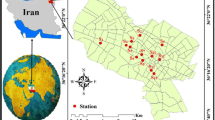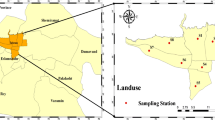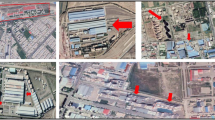Abstract
Asbestos, as with other pollutants in the air, has adverse effects on the health of human beings and animals. Today, the relationship between presence of asbestos fibers in the air breathed by humans and developing serious diseases such as lung cancer (asbestosis) and mesothelioma has been proven. This study was designed and conducted within the time period of August 2017 and June 2018 to determine the concentration of asbestos fiber in the ambient air of Shahryar City and to evaluate their health effects for the general population of the city. For this purpose, samples were taken from four points, and overall 32 air samples were taken along the year. The samples were then analyzed by the phase contrast microscopy (PCM) method. Also, to investigate the type of asbestos and for more accurate counting of fibers, SEM analysis was utilized. Finally, based on the EPA IRIS method, the health effects resulting from asbestos risks were also evaluated. The results of this study indicated that the mean annual concentration of asbestos fiber in the ambient air of Shahryar City was obtained as 0.0019 f/ml PCM and 0.0072 f/ml SEM. Furthermore, the most polluted point was S1 point (0.0119 –0.0026 f/ml, PCM), while the lowest concentration was related to S4 point (0.001 f/ml PCM–0.0021 f/ml SEM). The mean annual risk resulting from airborne asbestos fiber in the ambient air of Shahryar City for all samples was obtained as 1.72 × 10−6 to 2.2 × 10−4, which was higher than the recommended risk range in some points.






Similar content being viewed by others
References
Arfaeinia H, Asadgo Z, Ahmadi E, Seifi M, Moradi M, Dobaradaran S (2017) Characteristics, distribution and sources of polychlorinated biphenyls (PCBs) in coastal sediments from the heavily industrialized area of Asalouyeh, Iran. Water Sci Technol 76:3340–3350
Awad AHA (2011) Airborne asbestos fibres and mesothelioma in the last 20 years in Egypt: a review. Atmos Poll Res 2:445–451
Benner TC (2004) Brief survey of EPA standard-setting and health assessment. ACS Publ 38:3457–3464
Berman DW (2010) Comparing milled fiber, Quebec ore, and textile factory dust: has another piece of the asbestos puzzle fallen into place? Crit Rev Toxicol 40:151–188
Berman DW, Crump KS (2008) A meta-analysis of asbestos-related cancer risk that addresses fiber size and mineral type. Crit Rev Toxicol 38(Suppl 1):49–73
Breysse P, Cherrie J, Lees P, Brown P (1994) Comparison of Niosh 7400 “B” rules and WHO reference methods for the evaluation of airborne man-made mineral fibres. Ann Occup Hyg 38:527–531
Clinkenbeard JP (2005) Guidelines for geologic investigations of naturally occurring asbestos in California. In: Geological Society of America abstracts with programs
Covello VT, Merkhoher MW (2013) Risk assessment methods: approaches for assessing health and environmental risks, Springer Science & Business Media
Dodson RF, Hammar SP (2011) Asbestos: risk assessment, epidemiology, and health effects, 2nd edn. CRC press, p 512–519
Ghorbani S, Hajizadeh Y (2016) Monitoring of airborne asbestos fiber concentrations in high traffic areas of Isfahan, Iran in summer 2015. Int J Environ Health Eng 5:8–8
Gualtieri AF, Mangano D, Gualtieri ML, Ricchi A, Foresti E, Lesci G, Roveri N, Mariotti M, Pecchini G (2009) Ambient monitoring of asbestos in selected Italian living areas. J Environ Manag 90:3540–3552
Harding A-H, Darnton A, Wegerdt J, Mcevenny D (2009) Mortality among British asbestos workers undergoing regular medical examinations (1971–2005). Occup Environ Med 66:487–495
Jafari AJ, Kermani M, Kalantary RR, Arfaeinia H (2018) The effect of traffic on levels, distribution and chemical partitioning of harmful metals in the street dust and surface soil from urban areas of Tehran, Iran. Environ Earth Sci 77:38
Kakooei H, Marioryad H (2010) Evaluation of exposure to the airborne asbestos in an automobile brake and clutch manufacturing industry in Iran. Regul Toxicol Pharmacol 56:143–147
Kakooei H, Meshkani M, Azam K (2013) Ambient monitoring of airborne asbestos in non-occupational environments in Tehran, Iran. Atmos Environ 81:671–675
Kakooei H, Normohammadi M (2014) Asbestos exposure among construction workers during demolition of old houses in Tehran, Iran. Ind Health 52:71–77
Kakooei H, Yunesian M, Marioryad H, Azam K (2009) Assessment of airborne asbestos fiber concentrations in urban area of Tehran, Iran. Air Qual Atmos Health 2:39–45
Karbasdehi VN, Dobaradaran S, Nabipour I, Arfaeinia H, Mirahmadi R, Keshtkar M (2016) Data on metal contents (As, Ag, Sr, Sn, Sb, and Mo) in sediments and shells of Trachycardium lacunosum in the northern part of the Persian Gulf. Data Brief 8:966–971
Khadem M, Somea MS, Hassankhani H, Heravizadeh OR (2018) Joint Iranian-Russian studies of airborne asbestos concentrations in Tehran, Iran, in 2017. Atmos Environ 186:9–17
Lee RJ, Van Orden DR (2008) Airborne asbestos in buildings. Regul Toxicol Pharmacol 50:218–225
Marioryad H, Kakooei H, Shahtaheri SJ, Yunesian M, Azam K (2011) Assessment of airborne asbestos exposure at an asbestos cement sheet and pipe factory in Iran. Regul Toxicol Pharmacol 60:200–205
Millette JR (2006) Asbestos analysis methods. Asbestos: risk assessment, epidemiology, and health effects 50:9–38
Mokhtari M, Jafari N, Mohammadi A, Hajizadeh Y, Ghanbari R, Nemati S & Abdolahnejad A (2018) Temporal and spatial trends of airborne asbestos fiber concentrations in the urban areas of Yazd, Iran. Int J Environ Sci Technol, 1–10
Mousavi SM, Gouya MM, Ramazani R, Davanlou M, Hajsadeghi N, Seddighi Z (2008) Cancer incidence and mortality in Iran. Ann Oncol 20:556–563
Mullaugh KM, Hamilton JM, Avery GB, Felix JD, Mead RN, Willey JD, Kieber RJ (2015) Temporal and spatial variability of trace volatile organic compounds in rainwater. Chemosphere 134:203–209
Nichols MD, Young D & Davis G 2002. Guidelines for geologic investigations of naturally occurring asbestos in California. California geological survey public information offices Special publication, 124
Pastuszka JS (2009) Emission of airborne fibers from mechanically impacted asbestos-cement sheets and concentration of fibrous aerosol in the home environment in Upper Silesia, Poland. J Hazard Mater 162:1171–1177
Paustenbach DJ, Richter RO, Finley BL, Sheehan PJ (2003) An evaluation of the historical exposures of mechanics to asbestos in brake dust. Appl Occup Environ Hyg 18:786–804
Pawełczyk A, Božek F (2015) Health risk associated with airborne asbestos. Environ Monit Assess 187:428
Perkins RA, Hargesheimer J, Vaara L (2008) Evaluation of public and worker exposure due to naturally occurring asbestos in gravel discovered during a road construction project. J Occup Environ Hyg 5:609–616
Raeisi A, Arfaeinia H, Seifi M, Shirzad-Siboni M, Keshtkar M, Dobaradaran S (2016) Polycyclic aromatic hydrocarbons (PAHs) in coastal sediments from urban and industrial areas of Asaluyeh Harbor, Iran: distribution, potential source and ecological risk assessment. Water Sci Technol 74:957–973
Singh O. 2013. Mining environment: problems and remedies. Regency publications, p 1–16
Tarone RE (2018) On the International Agency for Research on Cancer classification of glyphosate as a probable human carcinogen. Eur J Cancer Prev 27:82–87
Wagner JC, Sleggs C, Marchand P (1960) Diffuse pleural mesothelioma and asbestos exposure in the North Western Cape Province. Occup Environ Med 17:260–271
Wei B, Yang L-S, Zhang X-W, Zhang B, Yu J-P & Jia X-J 2012. Airborne crocidolite asbestos fibers in indoor and outdoor air in a rural area, China
Funding
The authors received financial and technical support (Grant No. 31563) for this research from the Environmental and Occupational Health Center and Iran University of Medical Sciences.
Author information
Authors and Affiliations
Corresponding authors
Additional information
Responsible editor: Philippe Garrigues
Publisher’s Note
Springer Nature remains neutral with regard tojurisdictional claims in published maps and institutional affiliations.
Rights and permissions
About this article
Cite this article
Taghizadeh, F., Jafari, A.J., Gholami, M. et al. Monitoring of airborne asbestos fibers in an urban ambient air of Shahryar City, Iran: levels, spatial distribution, seasonal variations, and health risk assessment. Environ Sci Pollut Res 26, 6450–6459 (2019). https://doi.org/10.1007/s11356-018-4029-0
Received:
Accepted:
Published:
Issue Date:
DOI: https://doi.org/10.1007/s11356-018-4029-0




